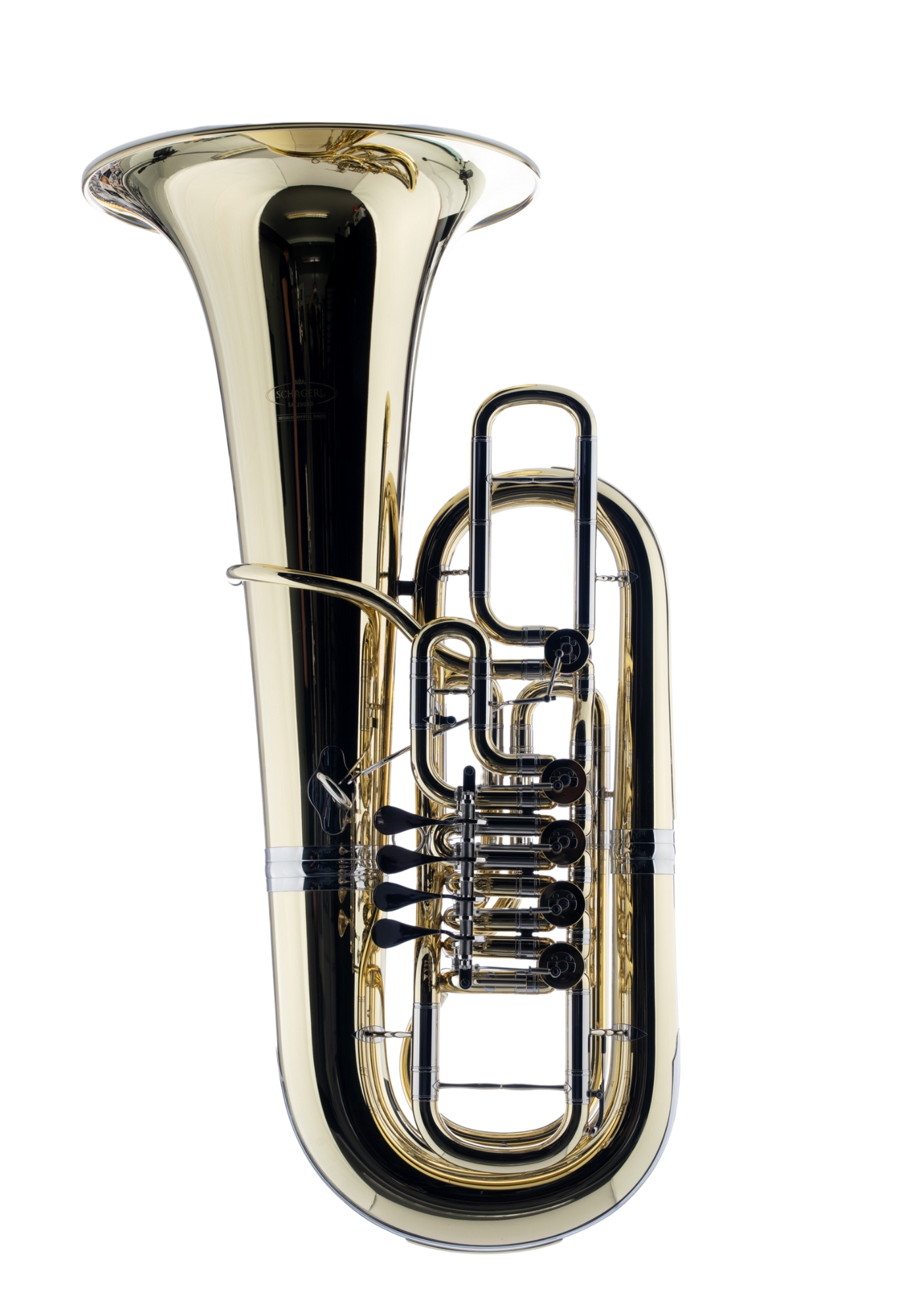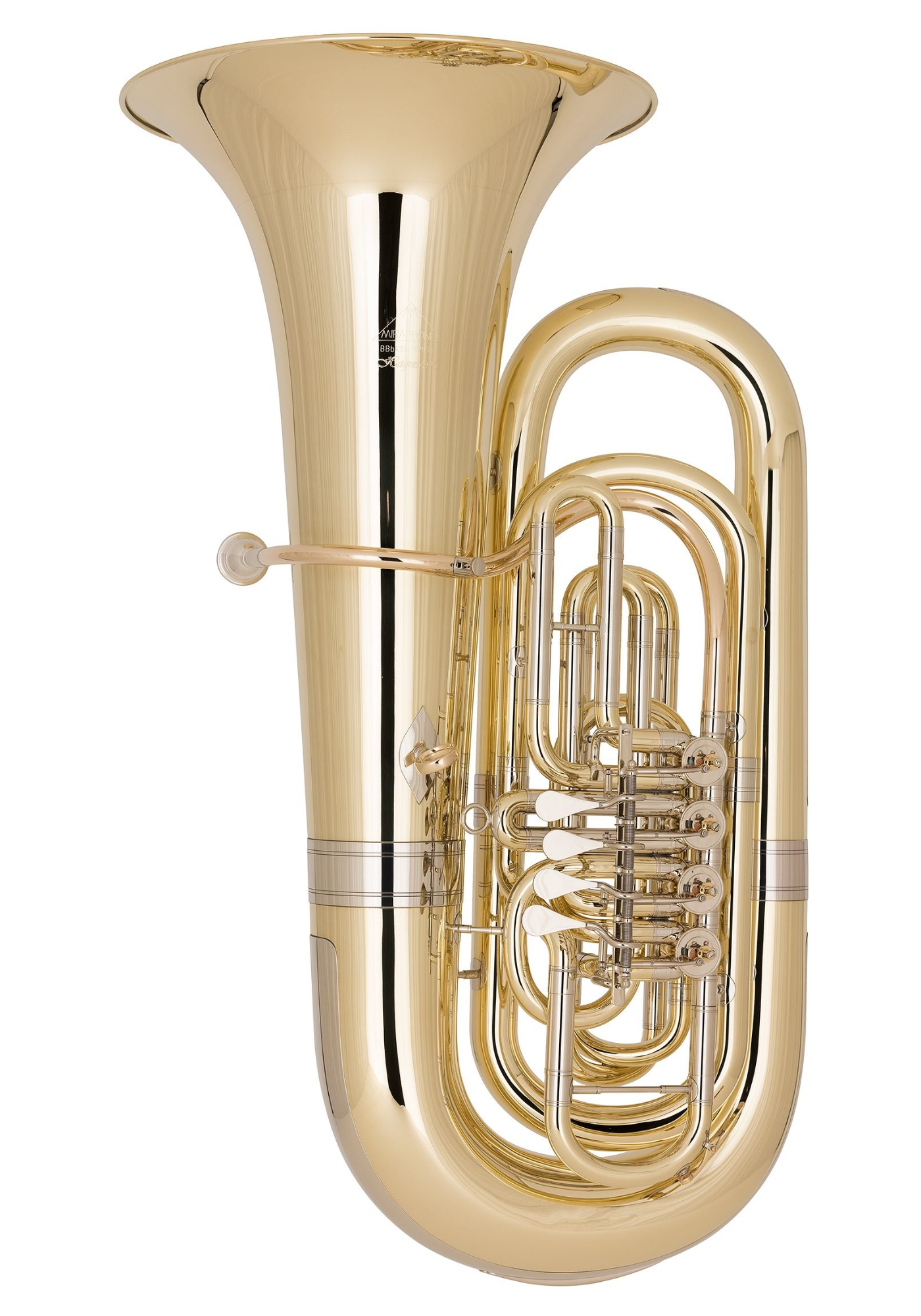
Tuba
Tuba – The foundation of brass music
The tuba is the largest and lowest-pitched of all brass instruments and forms the indispensable tonal foundation in many genres of music. With its full, rich and warm sound, it provides the bass line and gives wind orchestras, brass bands, jazz ensembles and even symphony orchestras the necessary depth. The tuba gives music an earthy, powerful foundation that plays a supporting role in rhythmic accompaniment and harmonic background music.
Discover the renowned Salzburg series, a line of instruments that bridges the gap between classical concert music and traditional brass music.
The special features of the tuba
The tuba is a low-pitched brass instrument, usually tuned to F, B flat, E flat or C, and its design and tube length enable it to cover a particularly low range. With a tube length of up to six metres and a large bell, the tuba is the largest instrument in the brass family. Sound is produced by buzzing (vibrating the lips) on the mouthpiece, combined with air flow and pressure on the valves.
The history of the tuba
The tuba was developed in the 19th century and is one of the younger brass instruments. Its invention is usually attributed to the German instrument maker Wilhelm Friedrich Wieprecht, who patented the first tubas in 1835. The tuba quickly became popular in military bands and wind orchestras, often replacing the serpent (an older bass instrument) as the source of bass tones. With the increasing importance of the bass line in orchestral music, the tuba also found its way into the classical symphony orchestra and was appreciated by composers such as Wagner, Mahler and Strauss for its powerful, harmonious accompaniment.
The different types of tuba
There are several types of tuba, which differ in tuning, construction and range.
The most commonly played types of tuba are:
Bb tuba: The most widely used tuba, especially in wind orchestras and brass bands. It has a low pitch and is often used for bass lines.
F tuba: This smaller tuba has a higher pitch and is often used in solo and orchestral pieces as it is more agile and easier to play.
C tuba: Particularly common in the USA, where it is preferred in orchestras. It offers a brighter bass sound and a more precise tone.
E-flat tuba: Rather rare and also used for higher bass registers, especially in British brass bands. It is smaller and more agile than the B-flat tuba and is well suited for fast melody lines.
Bb tuba: The most widely used tuba, especially in wind orchestras and brass bands. It has a low pitch and is often used for bass lines.
F tuba: This smaller tuba has a higher pitch and is often used in solo and orchestral pieces as it is more agile and easier to play.
C tuba: Particularly common in the USA, where it is preferred in orchestras. It offers a brighter bass sound and a more precise tone.
E-flat tuba: Rather rare and also used for higher bass registers, especially in British brass bands. It is smaller and more agile than the B-flat tuba and is well suited for fast melody lines.
Tips for beginners:
How to get started playing the tuba Playing the tuba requires strength and good breathing technique, as the low notes require a lot of air.
Here are a few tips for beginners who want to learn the tuba:
Choose a beginner's tuba: An F tuba or a smaller B tuba is often easier for beginners to handle and transport. Practise breathing technique: The right breathing technique is crucial. Breathing exercises for powerful and continuous air flow help you master the full tone of the tuba.
Practise regularly: The tuba requires regular practice, as control over the low register and breathing capacity need to be improved.
Oil the valves regularly: Proper care is important to keep the tuba ready for use and the valves smooth. This includes regularly oiling the valves and cleaning the mouthpiece.
Take lessons: Starting with a professional teacher is helpful for learning the correct playing technique and mastering the tuba.
Choose a beginner's tuba: An F tuba or a smaller B tuba is often easier for beginners to handle and transport. Practise breathing technique: The right breathing technique is crucial. Breathing exercises for powerful and continuous air flow help you master the full tone of the tuba.
Practise regularly: The tuba requires regular practice, as control over the low register and breathing capacity need to be improved.
Oil the valves regularly: Proper care is important to keep the tuba ready for use and the valves smooth. This includes regularly oiling the valves and cleaning the mouthpiece.
Take lessons: Starting with a professional teacher is helpful for learning the correct playing technique and mastering the tuba.
Frequently asked questions about the tuba
1. Is the tuba difficult to learn?
Playing the tuba requires strength and good breathing technique, as the low notes require a lot of air. However, with regular practice and an experienced teacher, the tuba can be learned successfully.
2. Which tuba is best for beginners?
A smaller F tuba or a B tuba with a compact design is often the best choice for beginners, as it is easier to handle and transport.
3. How do I properly care for my tuba?
Regular cleaning of the instrument and oiling of the valves are important to maintain the playability of the tuba and prevent corrosion. The mouthpiece should also be cleaned regularly.
4. How much does a good beginner's tuba cost?
Prices for beginner's tubas start at around €1,500, while high-quality tubas can cost several thousand pounds. Beginner's tubas with three valves are usually cheaper and easier to play.
Playing the tuba requires strength and good breathing technique, as the low notes require a lot of air. However, with regular practice and an experienced teacher, the tuba can be learned successfully.
2. Which tuba is best for beginners?
A smaller F tuba or a B tuba with a compact design is often the best choice for beginners, as it is easier to handle and transport.
3. How do I properly care for my tuba?
Regular cleaning of the instrument and oiling of the valves are important to maintain the playability of the tuba and prevent corrosion. The mouthpiece should also be cleaned regularly.
4. How much does a good beginner's tuba cost?
Prices for beginner's tubas start at around €1,500, while high-quality tubas can cost several thousand pounds. Beginner's tubas with three valves are usually cheaper and easier to play.
Buy a tuba at Schagerl:
Large selection: Schagerl offers a wide range of products, from cornets to an extensive range of accessories. Thanks to this variety, every musician can find the right instrument for their style and needs.Expert advice: Schagerl employs experienced musicians and specially trained staff who offer professional and personalised advice. Whether you are a beginner or a professional, every customer receives the support they need to find the perfect instrument.
Best customer service: Schagerl's customer service stands for reliability and commitment. In addition to personal advice, customers also benefit from services such as repairs, maintenance and accessory purchases, which make the entire purchasing process straightforward and enjoyable.







